How to choose suspended ceilings for kitchen: types of hinged structures
The kitchen has ceased to be a place where only cook and eat food. Increasingly, the interior of the kitchen is equipped so that the room was comfortable and cozy. Today, nobody is surprised by the quality repair, exclusive design, modern appliances. The ceiling is the most visible part of any room. An ideal solution for the kitchen can serve as suspended ceilings. Hanging ceilings in the kitchen will help to hide all the unevenness of the ceiling, disguise communications, reduce noise in the room. Such ceilings provide complete freedom to design ideas, allow you to install all kinds of built-in lights, create a mosaic pattern, make a multi-level ceiling.
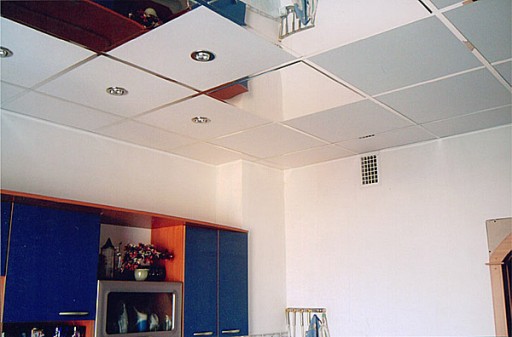
An unusual kind of kitchen is able to give a cassette suspended ceiling
Advantages of suspended ceilings in the kitchen
Many quite vainly refuse to install suspended ceilings, explaining this by the fact that the room is too low. In fact, glossy ceilings visually increase cubic capacity, expand space, “add” the kitchen a few centimeters of height. Due to their surface, they create a visual illusion, as the reflective properties of glossy ceilings are very high, they can be installed in small and dark kitchens.
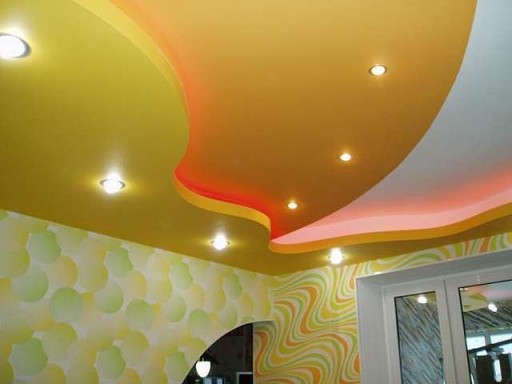
Original lines of different-level ceiling from gypsum cardboard will become the main detail of the interior decoration
Suspended ceilings look good in small, but very high rooms. Suspended ceilings help to remove the imbalance, “taking” a few extra centimeters of height. In addition, the ceiling will seem much lower if it is painted manually or in a saturated color.
Very often the ceiling needs to be “lifted”. Suspended ceilings very simply solve this problem. It is interesting to look at combined multi-tier ceilings, when one tier is made in light pastel or white color, and its middle is formed by a stretchy printed cloth. This option is economical: the frame is made of plasterboard, and the middle – from a seamless cloth, which needs only a few meters. Suspended ceilings are neat, hiding surface irregularities, durable in operation and easy to care for.
How to choose a suspended ceiling for a kitchen
When choosing a hanging ceiling, you need to follow two simple rules. First, pay attention to the appearance and hygienic parameters of the ceiling material, and secondly, the complexity of care for it. For the kitchen, you need to choose ceilings with a washable surface. These include suspended ceilings made of PVC film and seamless ceilings. Smooth surface of the material is not clogged with grease and soot, because such ceilings do not even accumulate ordinary dust. This is due to the structure and texture of the material. They are hygienic, do not collect condensate, easy to clean, do not interfere with natural air exchange.
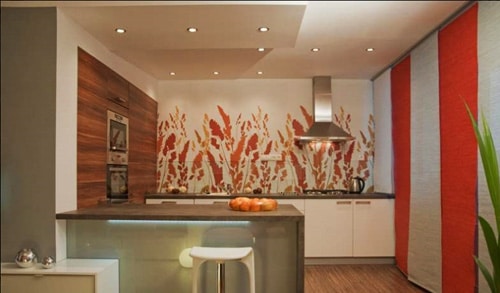
The ceiling with the built-in lighting system is one of the most common lighting methods, popular due to its practicality
Additional ventilation in the kitchen is very important. The possibility of embedding this system, makes the suspended ceilings an ideal option for decorating the kitchen. The design idea allows you to arrange the ventilation grilles so that they even decorate the interior. Particular attention should be given to lighting devices. Lamps built into the kitchen wall give a lot of soft light, which makes the work in the kitchen particularly enjoyable. In addition to standard functions, the built-in lamps arranged in a certain order give the interior an originality and a special style.
When choosing wooden suspended ceilings, it should be noted that wood will be exposed to steam, moisture, and soot every day. They belong to the elite class, they combine individuality and a respectable appearance. With proper care, wooden ceilings are durable, but still it is recommended for the kitchen to choose a different material, although many designers prefer wood.
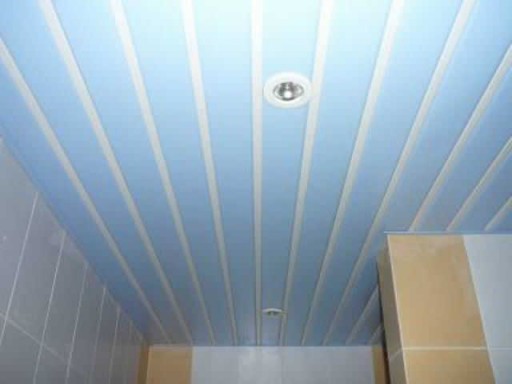
Reechny ceiling looks simple, no frills, but it is very practical and convenient to use
The budget option for arranging the suspended ceilings in the kitchen is plastic. It is easy to install and operate, easy to clean, durable. Plastic ceilings are resistant to moisture. In case of flooding, there are no divorces on the ceiling, the water slowly drains from the slits at the junction of the sheets. Plastic ceiling is very easy to clean. For white ceilings, wet cleaning is needed 1-2 times a year. If you select a ceiling in beige tones, then the dirt on it will be almost invisible. In this case, the ceiling can be wiped with a cloth with soapy water or a special solution every 1-2 years. Plastic perfectly hides all the flaws in the ceiling. Even having a bevel of 10 centimeters, the plastic ceiling perfectly masks this defect. The only drawback of this material is its fire hazard. When ignited, it emits smoke, smokes strongly, turns black. Many people do not pay attention to this quality, because the main factor that becomes decisive is the price.
Gypsum suspended ceilings in the kitchen allow to decorate the ceiling surface in different architectural styles. The advantage of gypsum is that it is a fireproof material, which is so important in the kitchen. The gypsum ceiling is easy to paint, has good sound insulation against extraneous noise. It is easy to hide various communications, ventilation, install lighting devices. Gypsum is simple in installation, gives in to the necessary deformation, which allows to make a multi-level ceiling, with different transitions. A relatively modest price makes this material one of the most popular in the construction sector.
When choosing the material of the canvas you need to pay attention to the manufacturer. Tests show that the Chinese suspended ceilings can withstand 500 washing cycles, while the canvases of European manufacturers can withstand up to 1000 cycles. Savings of 20% on the cost of substandard ceilings can be lost half the life of it.
Photo examples of the design of suspended kitchen ceilings
If you are interested in suspended ceilings, then you can get acquainted with various models and design solutions. Look at the suspended ceilings in the kitchen, the photos will help you decide on the type of ceiling that will suit your premises. Having become acquainted with examples of ceilings, you can choose a certain model, type of cloth, and translate the idea of repair into your interior.
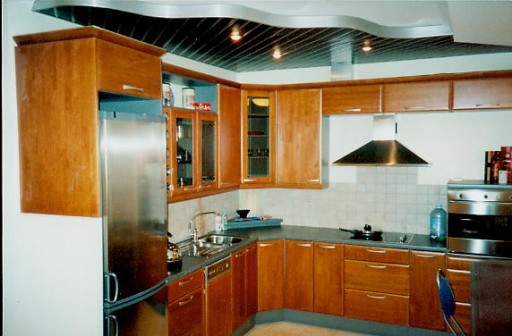
Suspended ceilings can zonate space and often this particular, rather than decorative function, is the defining

The original drawing, placed on the suspended ceiling, is able to completely transform the room, creating a wonderful mood day by day

A quiet unobtrusive image on the ceiling will not only decorate the room, but also create a feeling of peace and tranquility in the kitchen

Suspended ceilings in the kitchen are successfully combined with stretch ceilings, turning into a unique spectacular composition

Spot lights will add a simple slat ceiling of elegance and decorativeness
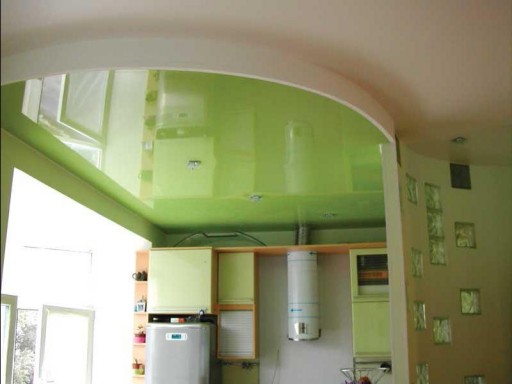
Thanks to the plasticity and compliance of stretch ceilings and plasterboard, ceiling structures can be given the most daring shapes and lines


